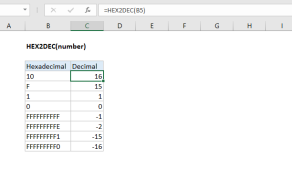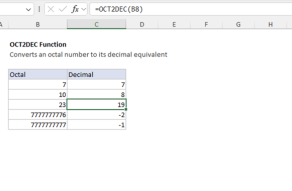Purpose
Return value
Syntax
=DECIMAL(number,radix)- number - A text string representing a number.
- radix - The base of the number to be converted, an integer between 2-36.
Using the DECIMAL function
The DECIMAL function converts a number in a known base into its decimal number equivalent. For example, the DECIMAL function can convert the binary number 1101 into the decimal number 13. The number provided to DECIMAL should be a text string.
The DECIMAL function takes two arguments: number and radix. Number should be the text representation of a number in a known base. Radix is the number of digits used to represent numbers (i.e. the base) and should be an integer between 2 and 36. The characters given in number need to conform to the numbering system specified with radix.
Examples
In the hexadecimal number system, the number 255 is represented as "FF". To convert the text string "FF" to the decimal number 255, you can use the DECIMAL function like this:
=DECIMAL("FF",16) // returns 255
To convert the binary number 1101 to its decimal number equivalent, 13, use DECIMAL like this:
=DECIMAL("1101",2) // returns 13
In the example shown, the numbers in column B are in different bases, and the base is given in column C. The formula in column D5 is:
=DECIMAL(B5,C5) // returns 3
As the formula is copied down, the DECIMAL function converts each number in column B to its decimal equivalent using the base specified in column C for the radix argument. The decimal numbers in column D are the output from DECIMAL.
BASE function
The BASE function performs the opposite conversion as the DECIMAL function:
=BASE(100,2) // returns "1100100"
=DECIMAL("1100100",2) // returns 100
See more on the BASE function here.
Number system characters
Different bases use different alphanumeric characters to represent numbers. The table below shows the characters uses for binary, octal, decimal, and hexadecimal number systems.
| Name | Base | Alphanumeric characters |
|---|---|---|
| binary | 2 | 0 - 1 |
| octal | 8 | 0 - 7 |
| decimal | 10 | 0 - 9 |
| hexadecimal | 16 | 0 - 9 and A - F |
Notes
- The number argument should be provided as a text string.
- The result from DECIMAL is a numeric value.
- If number is negative, DECIMAL returns a #NUM! error.
- if number contains a decimal value, DECIMAL returns a #NUM! error.
- If number is out-of-range for the given base, DECIMAL returns a #NUM! error.











